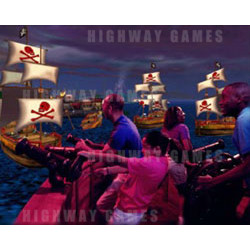The next generation in theatre attractions has been a movable feast for the entertainment simulation sector – current development of 4D passive attractions have not been seen as enough of an ‘E-Ticket' compared to the rollercoaster or big budget attraction. But this technology has a hidden punch.
The need for something beyond a passive ride film experience is never more important – as ‘Universal Studios' theme park admits to the closure of their once revolutionary ‘Back to the Future: The Ride'. Opened in 1991, the attraction was cited as the height of the motion ride and large screen mass audience experience – eight riders in 12 open ride cars viewing the experience above them on a giant 70-foot IMAX dome. But the audience has become more sophisticated; and with the closure of the attraction comes a need for the future.
Interactive Theatre Attraction (called ‘iD') is the big new development of the passive immersive experience for large audiences blended with the interactive game experience – a compelling repeat attendance attraction. But where next-generation attractions for the theme park and entertainment venue business hopes to go – the amusement industry has already trodden.
From amusement to actual attractions, the VR variant of mass audience interactive gaming was developed in 1997 by Ham on Rye who released the ‘Virtual Reality Theater' – the 24 seat experience featured passive films shown on the HMD, interspersed by an overlaid live actor commentary, and interactive mini games for all the audience. How interactive these mini-games actually were would never be fully developed and the concept after some initial placement would crumble under reliability and pure business realities.
Prior to selling iD as an attraction for venues to buy, it was considered to make the products an integral part of what was seen as the next generation in venue development creating ‘indoor theme parks' (theme parks in a box). The first American developer of the idea, (similar to the Asian Themed Attraction venue), was entertainment simulator corporation Iwerks. In an unusual agreement with the Foxwood Casino operation in 1993 to develop a multiple attraction component to their venue called ‘Cinetropolis'.
One of the new developments was to be a non-motion interactive experience – a simulator pod with an interactive game narrative. The ‘Virtual Adventure' offered a six-player experience that brought a 3D glasses display to life with players controlling a submersible on the hunt for the ‘Loch ness Monster' and her eggs! Never officially completed, and only shown in production prototype, the interactive experiences marked the beginning of a drive towards the utopian ideal.
The theme park industry started to turn to the possibilities that interactive theme park projects offered – one of the largest investments was from Walt Disney. They developed and launched in 1998 the ‘DisneyQuest' venue concept that would include two seminal attractions that showed the direction of iD. The ‘Invasion! An ExtraTERRORestrial Alien Encounter' offered pods for groups of four to steer across an alien terrain blasting aliens and saving astronauts. While ‘Pirates of the Caribbean: Battle for Buccaneer Gold' offered the rocking bridge of a sail ship blasting pirates and ghosts, all viewed through 3D goggles.
While SEGA's Asian Interactive theme park project stalled in Japan, the aspiration for the American market mutated into a relationship with DreamWorks and Universal, the resulting GameWorks became heavy on hype and thin on interactive attractions. The only one of the concept attractions to survive a brutal baptism was a six-rider 30-foot vertical free-fall attraction, previously developed as a mediocre multiple screen shooting game (a very poor man's version of Virtua Cop), but after a facility review it was decided to have a specialist attraction built to replace it. A competent development team would create a innovative balloon racing game experience building off of the ride platform with new software and so was launched ‘Sky Pirates'. The game being the only surviving multiple audience attraction of GW to this day - a sleeper hit that has seen thousands of riders with no publicity.
News Story with thanks to Kevin Williams, please visit
www.thestingerreport.com for the full story and others.




